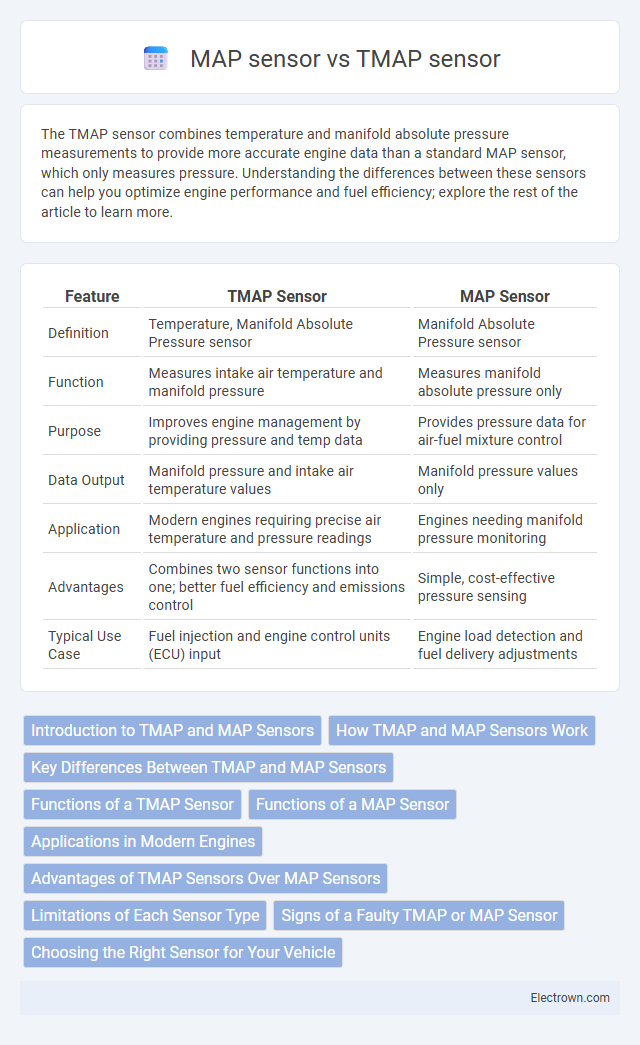The TMAP sensor combines temperature and manifold absolute pressure measurements to provide more accurate engine data than a standard MAP sensor, which only measures pressure. Understanding the differences between these sensors can help you optimize engine performance and fuel efficiency; explore the rest of the article to learn more.
Table of Comparison
| Feature | TMAP Sensor | MAP Sensor |
|---|---|---|
| Definition | Temperature, Manifold Absolute Pressure sensor | Manifold Absolute Pressure sensor |
| Function | Measures intake air temperature and manifold pressure | Measures manifold absolute pressure only |
| Purpose | Improves engine management by providing pressure and temp data | Provides pressure data for air-fuel mixture control |
| Data Output | Manifold pressure and intake air temperature values | Manifold pressure values only |
| Application | Modern engines requiring precise air temperature and pressure readings | Engines needing manifold pressure monitoring |
| Advantages | Combines two sensor functions into one; better fuel efficiency and emissions control | Simple, cost-effective pressure sensing |
| Typical Use Case | Fuel injection and engine control units (ECU) input | Engine load detection and fuel delivery adjustments |
Introduction to TMAP and MAP Sensors
TMAP (Temperature and Manifold Absolute Pressure) sensors combine temperature measurement and manifold pressure sensing in a single unit, providing more precise data for engine management systems. MAP (Manifold Absolute Pressure) sensors measure only the absolute pressure within the intake manifold, helping determine air density for accurate fuel delivery. The integration of temperature sensing in TMAP sensors enhances engine control accuracy by compensating for air temperature variations during combustion.
How TMAP and MAP Sensors Work
TMAP (Temperature and Manifold Absolute Pressure) and MAP (Manifold Absolute Pressure) sensors both monitor engine performance by measuring air pressure within the intake manifold, with TMAP sensors integrating an ambient air temperature sensor for enhanced accuracy. MAP sensors detect changes in air pressure to optimize fuel injection and ignition timing, while TMAP sensors provide additional temperature data to improve engine control under varying environmental conditions. Your vehicle's engine management system relies on these sensors to maintain efficient combustion and reduce emissions.
Key Differences Between TMAP and MAP Sensors
TMAP sensors measure Temperature, Manifold Absolute Pressure, and Atmospheric Pressure, allowing your engine control unit to optimize fuel delivery and ignition timing more accurately compared to MAP sensors, which only measure manifold pressure. TMAP sensors provide enhanced data for improved engine performance, fuel efficiency, and emissions control by integrating temperature readings. The inclusion of temperature measurement helps compensate for changes in air density, giving your vehicle precise engine management under varying conditions.
Functions of a TMAP Sensor
A TMAP sensor measures both temperature and manifold absolute pressure to provide accurate air density data for engine control. It enhances engine performance by adjusting fuel injection and ignition timing based on real-time temperature and pressure variations. Unlike a standard MAP sensor, the TMAP sensor enables more precise calculations of air mass flow, improving combustion efficiency and emissions control.
Functions of a MAP Sensor
A MAP (Manifold Absolute Pressure) sensor measures the air pressure inside the intake manifold, providing essential data for the engine control unit (ECU) to calculate air density and adjust fuel injection and ignition timing for optimal engine performance. Unlike a TMAP sensor, which combines temperature and manifold absolute pressure measurements, a standard MAP sensor focuses solely on pressure detection to monitor engine load and boost conditions. Your vehicle relies on the MAP sensor's accurate pressure readings to ensure efficient combustion, improve fuel economy, and reduce emissions.
Applications in Modern Engines
TMAP sensors combine temperature and manifold absolute pressure measurements, enhancing engine control in modern turbocharged and naturally aspirated engines by providing accurate data for air density calculation. MAP sensors measure only manifold pressure and are widely used in simpler fuel injection systems to optimize air-fuel mixture and ignition timing. Your engine management system benefits from TMAP sensors through improved fuel efficiency, emissions control, and performance under varying environmental conditions.
Advantages of TMAP Sensors Over MAP Sensors
TMAP sensors combine temperature measurement with manifold absolute pressure sensing, providing more accurate engine load calculation and improving fuel injection and ignition timing precision. This integrated functionality enables better adaptation to varying environmental conditions and enhances overall engine performance and emissions control. Compared to standard MAP sensors, TMAP sensors reduce the need for multiple sensors, lowering system complexity and potential failure points.
Limitations of Each Sensor Type
TMAP sensors face limitations related to increased complexity and higher cost due to their dual measurement of temperature and manifold absolute pressure, which can complicate calibration and integration. MAP sensors, while simpler and more cost-effective, have limitations in accurately compensating for temperature variations, potentially leading to less precise air density calculations under varying environmental conditions. Both sensor types can experience performance degradation under extreme temperatures and rapid pressure changes, affecting engine control accuracy.
Signs of a Faulty TMAP or MAP Sensor
A faulty TMAP sensor or MAP sensor can cause engine performance issues such as rough idling, poor fuel economy, and increased emissions. You may notice the Check Engine Light illuminating, hesitation during acceleration, or difficulty starting the engine. Diagnosing sensor faults early helps maintain proper air-fuel mixture and engine efficiency.
Choosing the Right Sensor for Your Vehicle
Choosing the right sensor for your vehicle depends on the specific engine management needs, where TMAP (Temperature and Manifold Absolute Pressure) sensors provide both pressure and temperature data for precise air density calculation, enhancing fuel efficiency and performance. In contrast, a standard MAP (Manifold Absolute Pressure) sensor measures only pressure, making it suitable for simpler engine setups with less emphasis on temperature compensation. Prioritizing a TMAP sensor ensures more accurate air-fuel mixture control in modern vehicles equipped with advanced engine management systems, while a MAP sensor remains a cost-effective solution for older or less complex engines.
TMAP sensor vs MAP sensor Infographic

 electrown.com
electrown.com